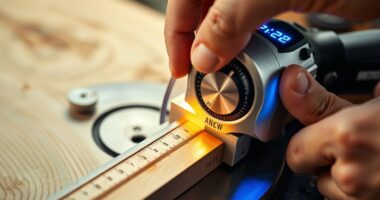To keep your workshop safe and efficient all year, create seasonal maintenance checklists focusing on tool calibration, cleaning, safety device inspections, and mechanical upkeep. Regularly check electrical cords, lubricate moving parts, and organize your workspace to prevent hazards. Updating your routines and setting reminders help uphold high standards throughout the year. Following these steps ensures your workshop stays productive and safe; discover more tips to optimize your maintenance practices as you continue.
Key Takeaways
- Schedule regular calibration checks for measurement tools to ensure precision year-round.
- Perform thorough cleaning and organization to maintain a safe, clutter-free workspace for seasonal workflows.
- Inspect safety devices and electrical equipment, replacing or repairing damaged components promptly.
- Lubricate moving parts and check for rust or corrosion during seasonal maintenance routines.
- Update maintenance checklists and set reminders for inspections, calibrations, and safety reviews throughout the year.

Maintaining your workshop throughout the year is essential to keep tools and equipment in top condition and guarantee safety. Regular upkeep minimizes breakdowns, extends the lifespan of your gear, and ensures that work gets done efficiently. One of the most critical aspects of this ongoing maintenance is tool calibration. Over time, tools can drift out of alignment or lose accuracy, which can compromise both the quality of your work and safety. By routinely calibrating your tools, especially measuring instruments, you ensure they deliver precise results every time. Incorporate calibration checks into your seasonal maintenance routines to prevent errors that could lead to accidents or defective products. Additionally, adhering to safety protocols during calibration is crucial to protect yourself from potential injuries. Always follow manufacturer instructions and use the appropriate protective gear when handling calibration equipment or working with sensitive tools. Regularly checking tool accuracy helps maintain high standards and reduces the risk of costly mistakes.
Regularly calibrate your tools to ensure accuracy, safety, and high-quality results in your workshop.
Beyond calibration, maintaining a clean and organized workspace is key. Dust, debris, and clutter not only slow down work but also create hazards. Regularly sweeping floors, wiping down surfaces, and properly storing tools reduces the risk of trips, falls, or accidental injuries. Pay special attention to power tools and electrical equipment; ensure cords are intact, outlets are safe, and no frayed wiring exposes you to shocks or fires. Seasonal checks should include inspecting safety devices such as guards, emergency stops, and fire extinguishers, replacing or repairing them as necessary. Keeping safety protocols visible and up to date reinforces safe practices, making it easier for everyone to follow proper procedures.
In addition to safety and calibration, lubrication and maintenance of moving parts help prevent wear and tear. Regularly oil or grease tools that have moving components, like saw blades, drills, or lathes. This reduces friction, prevents overheating, and maintains peak performance. During seasonal maintenance, check for signs of rust, corrosion, or damage. Address these issues immediately to avoid more costly repairs or safety hazards later on. If your workshop operates in a humid climate, consider dehumidifiers or moisture absorbers to protect sensitive equipment from rust.
Finally, review and update your maintenance checklist periodically. As your workshop evolves or new tools are added, you’ll need to adjust your routines accordingly. Set reminders for periodic inspections, calibration, and safety checks. By staying proactive and diligent, you create a safer, more efficient workspace year-round. Remember, a well-maintained workshop isn’t just about productivity; it’s about safeguarding yourself and others while ensuring every project meets the highest standards.
Frequently Asked Questions
How Often Should Tools Be Calibrated During Seasonal Checks?
You should calibrate your tools at least once a season to guarantee tool accuracy. Calibration frequency depends on how often you use the tools and their precision requirements; high-precision tools may need monthly checks. Regular calibration helps prevent errors, maintains safety, and ensures quality. Keep a schedule and record each calibration to stay on top of tool accuracy, especially during seasonal changes when environmental factors can affect performance.
What Safety Precautions Are Recommended During Workshop Maintenance?
Think of workshop safety like a shield protecting you in a storm—you must wear protective gear at all times. Always don gloves, goggles, and ear protection, especially when handling hazardous materials. Keep hazard signs visible and clear to alert everyone of potential dangers. Before starting maintenance, make certain power is off and tools are secured. Staying vigilant and using proper safety precautions helps prevent accidents and keeps your workspace safe.
Are There Eco-Friendly Cleaning Options for Workshop Equipment?
Yes, you can choose eco-friendly cleaning options for your workshop equipment. Opt for biodegradable cleaners that break down naturally and reduce environmental harm. You might also use natural disinfectants like vinegar or tea tree oil, which are effective and non-toxic. These alternatives help maintain a safe workspace while minimizing your ecological footprint, ensuring that your workshop stays clean and green without relying on harsh chemicals.
How Can I Track Maintenance History Effectively?
You can track maintenance history effectively through digital tracking, which keeps your records organized and accessible. Don’t worry about complex systems; maintenance logs can be easily digitized using simple software or apps. This way, you guarantee no service is overlooked, extend equipment lifespan, and quickly identify recurring issues. Digital tracking saves time and reduces errors, helping you stay on top of maintenance routines and making future planning more efficient.
What Budget Considerations Should I Keep in Mind?
When planning your maintenance budget, focus on realistic budget planning and prioritize essential tasks to avoid overspending. Keep costs optimized by comparing prices for equipment and supplies regularly, and consider preventive maintenance to reduce costly repairs later. Track your expenses diligently to identify areas where you can cut costs without sacrificing quality. This approach guarantees your workshop stays well-maintained while staying within your financial limits.
Conclusion
Now that you’ve got your seasonal maintenance checklists in place, you’re ready to tackle the workshop’s needs. But remember, each season brings surprises—unexpected issues that could catch you off guard. Stay vigilant and keep your tools sharp, because the next challenge might be just around the corner. Are you prepared for what’s coming? Keep your checklist handy, and you’ll be ready to face whatever surprises the workshop throws your way.









